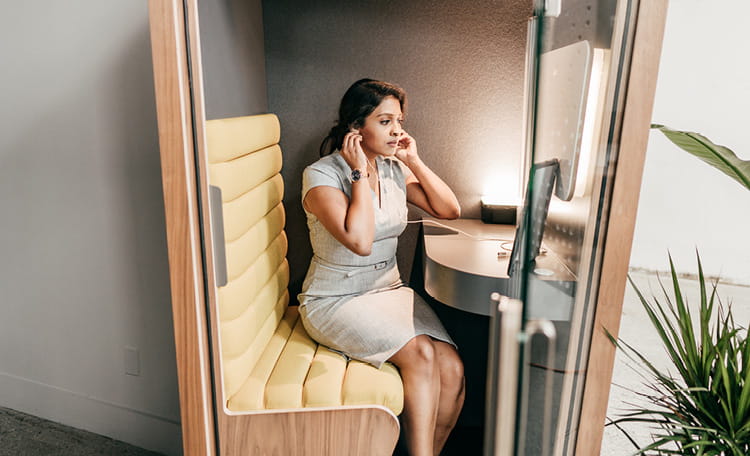
Once valued as an exclusive perk— only five percent of the U.S. workforce1 were working from home (WFH) full-time prior to the COVID-19 pandemic—remote work has seen an unprecedented increase as employers do their part to enable social distancing. As of April 2021, 84 percent of global office workers are WFH and 40-50 percent say they want to continue when the outbreak ends, at least some of the time.2 While remote work has solidified its place in a post-pandemic economy, it unfortunately comes with downsides to employees’ long-term mental and physical health as it can tend to be isolating and overly sedentary for some. To mitigate these negative impacts, organizations must rethink their workplace strategies, doubling down on employee wellness and enabling their people to do their best work, both in and outside of the office.

Remote working’s isolation, longer hours, poor home office setups, sitting for prolonged periods and blurred lines between home and office are taking a toll:
- There has been an increase in anxiety and stress during the pandemic lock-down and restrictions have led to an increase in sedentary behaviors, sleep disruption and weight gain.3
- 54 percent of respondents in a recent WebMD poll confirm weight gain during COVID-19 restrictions. Remote workers engaging in “distracted eating” as many set up makeshift home offices in their kitchens.4
- 92 percent of respondents of the American Chiropractic Association’s Council on Occupational Health poll report an increase in musculoskeletal conditions and pain as a result of working from home.5
- 42 percent of those who work from home report frequent night waking compared to 29 percent of office workers in a global UN study that includes research on the stress associated with mobile devices.6
- Nearly 70 percent of professionals who transitioned to remote work because of the pandemic say they now work on the weekends, and 45 percent say they regularly work more hours during the week than they did before.7
A Diminished Sense of Employee Wellbeing
While stay-at-home measures across the country have yielded tremendous cultural and operational shifts towards remote working, the physical and mental wellbeing of employees in an remote-heavy working model is taking a hit. According to Cushman & Wakefield’s Experience per Square FootTM (XSF) global survey focused on remote work that included more than 70,000 respondents, only 56 percent of respondents feel connected to their colleagues and just 55 percent report feeling a sense of wellbeing, indicative of low levels of energy and not enough time away from work. The struggles of remote work are particularly evident among younger generational groups, with 72 percent of Millennial and Gen Z employees reporting work from home challenges. These challenges revolve around caregiver responsibilities and inadequate workspace—obvious impediments to productivity and wellbeing.
CRE Must Evolve to Meet the Evolving Needs of Employees
Health and wellness will be among the top needs for workers and they will increasingly expect their employers to emphasize their wellbeing. One-way companies can do that is through more flexible workplace solutions. Employees want and expect remote work options post-pandemic—nearly four out of five respondents of the XSF Survey feel their companies should embrace flexible working. And as it turns out, hybrid models have been on the Future of Work trajectory for some time; the pandemic has been only a catalyst for this shift to flexible working solutions. A 2020 Gallup study published prior to COVID-19 confirmed that employee engagement is lowest (30 percent) at either extreme: when working remotely none of the time or when working remotely more than 80 percent of the time.8
A second way organizations can support wellbeing is through a fundamental reset on building amenities. Increasingly, employees and companies will require more from the built environment, such as increased access to nature, biophilia, wellness certifications and building management systems that improve lighting conditions, thermal comfort, air and more. As landlords face greater pressure to evaluate and improve the health, safety and environmental performance of their buildings, this new class of wellbeing-focused considerations and amenities will likely prove to be worthwhile investments.
We asked more than 20,000 people from 18 companies globally why they want to come back into their office. Here’s what they told us:
- To socialize with my colleagues
- To collaborate or attend meetings in person
- To get better access to tools and physical resources
- To network with and be visible to leadership
- To feel more connected to the company culture
- To be exposed to informal learning opportunities
- To separate work from my personal life
- To have a better workspace set-up
- To feel more in tune with what’s happening in the business
“Post pandemic, we will return to the workplace having dealt with both the physical and mental health impacts of the largest modern-day pandemic in our history,” asserts Whitney Austin Gray, PhD, Senior VP, International WELL Building Institute (IWBI). “We will move from quarantine and isolation to community and engagement. Offices that are designing for the workplace of the future that take into account physical and mental health will be prepared for the next part of this pandemic, which will be around healing, recovery, and resilience.”
A third way organizations can support wellness is to enable employees to do their best work by ensuring they have appropriate working environments, whether at home or in the office. Companies should consider its employees’ needs across the physical environment that promote wellbeing and productivity. These may include technology and peripherals (laptops, monitors, headsets), access to natural light and air quality (filtration systems), physiology (ergonomic setup of chairs, desks and monitors) and operational services (productivity software, technology support, mail services).
To further support mental and physical wellbeing, policies and health coverage that provides employees with benefits and resources for anxiety and depression can be critical. Employers can expect that some employees may be experiencing increased stress related to an anticipated return to the office, and then work to ensure all necessary measures are implemented to care for their teams as they resume work in the hybrid workplace.
Ensuring a Healthy Workplace, Both in and out of the Office
While the physical office will continue to play a pivotal role in facilitating day-to-day operations and collaboration, employers must now consider how to better support organizational cohesiveness, culture and colleague-to-colleague connection—no matter where its employees work.
“The era of toxic work cultures and burnout being an individual issue will likely be replaced with it being a collective responsibility of the employer, especially when workers can opt to stay home,” adds Dr. Gray. “Companies that proactively create environments for mental and physical health will be setting the curve to attract top talent in this new era of workplace wellness.” Flexible spaces will increase as companies look to adapt to different needs throughout the day— reconfigurable furniture and walls that transform a casual learning area to an open space for social events, for example.
To achieve this, organizations must redefine the purpose of the office to facilitate collaboration and knowledge sharing, two areas significantly hindered by the shelter in place restrictions. The most dynamic in-office workplaces will ultimately be those that work as active central hubs, a place where colleagues come together to build community, innovate, socialize and engage in ad hoc conversations.
Read the full article.



